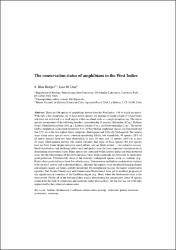/admin/item?itemID=7d8ff9f3-d326-4d05-87b8-e40888c11934
The conservation status of amphibians in the West Indies

View/
Type of Access
OpenMaterial Type
Book (chapter)Type of Content
Scientific researchLanguage
EnglishCollection
- Investigación ambiental [1759]
Metadata
Show full item record| Abstract: | There are 196 species of amphibians known from the West Indies, 188 of which are native. With only a few exceptions, all of those native species are endemic to single islands or island banks, and most are restricted to a small region within an island, such as a single mountain top. The native species are members of the following families: Aromobatidae (1 species), Bufonidae (12 sp.), Hylidae (9 sp.), Eleutherodactylidae (161 sp.), Leptodactylidae (3 sp.), and Strabomantidae (2 sp.). The recent Global Amphibian Assessment found that 84% of West Indian amphibian species are threatened and that 71% are in the two highest threat categories, Endangered and Critically Endangered. The remote areas where many species occur constrain monitoring efforts, but remarkably, 49 species (26% of all native species) have not been observed in at least 10 years and 31 species (16%) in at least 20 years. Much-needed surveys will almost certainly find some of those species, but five species have not been found despite intensive search efforts and are likely extinct for unknown reasons. Small distributions and declining habitat area and quality were the most important considerations in determining conservation status. Many species are contained within national parks and other protected areas, but the effectiveness of the protected areas varies from essentially no protection to moderately good protection. Unfortunately, most of the critically endangered species occur in countries (e.g., Haiti) where protected areas have low effectiveness. Deforestation and habitat modification continue to be the most serious and widespread threats, although the impacts of an introduced fungal pathogen and climate change are being carefully monitored. For unexplained reasons, the largest conservation agencies, The Nature Conservancy and Conservation International, have yet to establish programs of any significance in countries of the Caribbean region (e.g., Haiti) where the biodiversity crisis is the most severe. Nearly all of the biological data used in determining the conservation status of species comes from the field of systematics and taxonomy rather than ecology, yet this fact has yet to be fully appreciated by the culture of conservation. |
| Author(s): | Hedges, S. Blair
Díaz, Luis M. |
| Date: | 2011 |
| Published: | Conservation of Caribbean Island Herpetofaunas Volume 1: Conservation Biology and the Wider Caribbean (pp. 31-47). Brill. |
| Citation: | Hedges, S. B., & Díaz, L. M. (2011). The conservation status of amphibians in the West Indies. In Conservation of Caribbean Island Herpetofaunas Volume 1: Conservation Biology and the Wider Caribbean (pp. 31-47). Brill. Recuperado de: |
| URI: | https://bvearmb.do/handle/123456789/5423
|

